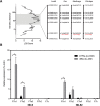Genetic analysis of early phenology in lentil identifies distinct loci controlling component traits
- PMID: 35290451
- PMCID: PMC9238442
- DOI: 10.1093/jxb/erac107
Genetic analysis of early phenology in lentil identifies distinct loci controlling component traits
Abstract
Modern-day domesticated lentil germplasm is generally considered to form three broad adaptation groups: Mediterranean, South Asian, and northern temperate, which correspond to the major global production environments. Reproductive phenology plays a key role in lentil adaptation to this diverse ecogeographic variation. Here, we dissect the characteristic earliness of the pilosae ecotype, suited to the typically short cropping season of South Asian environments. We identified two loci, DTF6a and DTF6b, at which dominant alleles confer early flowering, and we show that DTF6a alone is sufficient to confer early flowering under extremely short photoperiods. Genomic synteny confirmed the presence of a conserved cluster of three florigen (FT) gene orthologues among potential candidate genes, and expression analysis in near-isogenic material showed that the early allele is associated with a strong derepression of the FTa1 gene in particular. Sequence analysis revealed a 7.4 kb deletion in the FTa1-FTa2 intergenic region in the pilosae parent, and a wide survey of >350 accessions with diverse origin showed that the dtf6a allele is predominant in South Asian material. Collectively, these results contribute to understanding the molecular basis of global adaptation in lentil, and further emphasize the importance of this conserved genomic region for adaptation in temperate legumes generally.
Keywords: Adaptation; FT genes; QTL analysis; controlled environment; florigen; flowering time; legume; lentil; mapping; photoperiod.
© The Author(s) 2022. Published by Oxford University Press on behalf of the Society for Experimental Biology. All rights reserved. For permissions, please email: journals.permissions@oup.com.
Figures






References
-
- Beales J, Turner A, Griffiths S, Snape JW, Laurie DA.. 2007. A pseudo-response regulator is misexpressed in the photoperiod insensitive Ppd-D1a mutant of wheat (Triticum aestivum L.). Theoretical and Applied Genetics 115, 721–733. - PubMed
-
- Erskine W, Adham Y, Holly L.. 1989. Geographic distribution of variation in quantitative traits in a world lentil collection. Euphytica 43, 97–103.
-
- Erskine W, Chandra S, Chaudhry M, Malik IA, Sarker A, Sharma B.. 1998. A bottleneck in lentil: widening its genetic base in South Asia. Euphytica 101, 207–211
-
- Erskine W, Ellis RH, Summerfield RJ, Roberts EH, Hussain A.. 1990. Characterization of responses to temperature and photoperiod for time to flowering in a world lentil collection Theoretical and Applied Genetics 80, 193–199. - PubMed
Publication types
MeSH terms
Grants and funding
LinkOut - more resources
Full Text Sources

